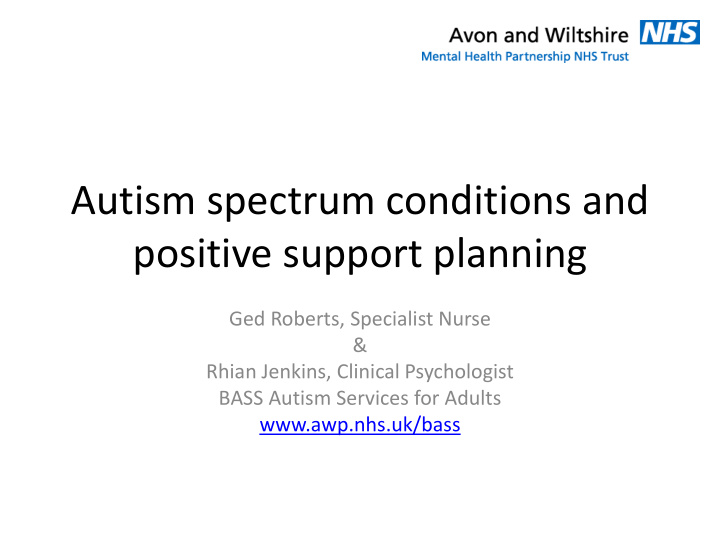



Autism spectrum conditions and positive support planning Ged Roberts, Specialist Nurse & Rhian Jenkins, Clinical Psychologist BASS Autism Services for Adults www.awp.nhs.uk/bass
Autism spectrum conditions and positive support planning Hopes for session? Plan: 1. BASS 2. Autism and distressed behaviour 3. Ways of understanding 4. Ways of assessing 5. Formulation 6. Positive support plans 7. Promoting the effectiveness of positive support plans
Bristol Autism Spectrum Service • We offer: – workforce support across the care pathway (including health, social care and voluntary sector organisations) involved in providing services to this client group. – direct contact with people with ASC who are not able to access existing provision due to the absence of significant psychiatric co-morbidity and/or learning disability
Distressed Behaviour and People with ASC • Possible triggers for distressed behaviour: – Communication (John) – Change in routine (Daniel) – Sensory issues (Catherine and Neil) – Understanding of social rules, sexuality etc • Also: - Trauma, abuse, significant life events, attachment (EIoC) - Medical conditions and medication - Mental health problems Essentially the same reasons as other people!
Psychiatric comorbidity in young adults with a clinical diagnosis of Asperger syndrome (Lugnegard et al 2011) (back) Total (N = 54) Women (N = 28) Men (N = 26) N % N % N % Life-time major depression 38 70 20 71 18 69 Any anxiety disorder 30 56 16 57 14 54 Brief psychotic disorder 1 2 1 4 – – Psychotic syndrome NOS 1 2 – – 1 4 Recurrent hallucinations 7 13 4 14 3 11 Bulimia nervosa 2 4 2 7 – – Any substance dependence 6 7 1 4 5 19 Alcohol dependence 4 7 1 4 3 12 Drug dependence 4 7 1 4 3 12 ADHD 16 30 8 29 8 31 Tourette syndrome 1 2 – – 1 4
What is this?
Time-Intensity Model
T/I Exercise 1. Pair up 2. One person is the interviewer 3. Interviewer supports their partner to complete time intensity model about a time when they became or behaved in a way which they regretted later. 4. Swap around.
T/I Exercise • Reflect as a group: • What was it like to be the interviewer? • What was it to be interviewed? • How could you use this with someone you work with?
Making sense of distressed behaviour: Functional Assessment • An ABC form is a tool for capturing data about the occurrence of distressed behaviour…. • A ntecedent • B ehaviour • C onsequence • …with the aim of trying to understand the function of the behaviour
Example ABC Chart
Functional Assessment (cont) • Why use ABC forms? - Helpful for building up evidence about distressed behaviour, for example: - What are the behaviours? - How often do they occur? - How long do they last? - What might be affecting the behaviour (e.g. sleep, medication, communication difficulties, available choice) - Situations in which the behaviour is more or less likely to occur e.g. people, activities, time of day - What the function of the behaviour may be - What responses may maintain the behaviour - What positive strategies may be used
Functional Assessment (cont) - i.e. Can help to focus our minds and de-bunk myths that evolve about the circumstances and reasons for distressed behaviour - Provides evidence base for formulation & intervention
Making sense of distressed behaviour: Formulation What is formulation? • A hypothesis about a person’s difficulties which draws on psychological theory • Essentially, a way of making sense of a person’s situation and experiences • A way of bringing all the information together
Intervention Planning: Positive Support Plans • A way to help staff support the person positively • Based on a holistic understanding of the person • Aiming to increase the person’s quality of life
Example 1
Example 2
Positive support Plans: • What do you think of these different plans? • Would they be applicable for people you work with? • What about them do you like and dislike?
Promoting the success of Positive Behaviour Support • Distressed behaviour does not occur in a vacuum Plus, society, narratives about distressed behaviour, policy context
Hutchinson, Hastings et al (in press)
So what can we do to support staff teams? • Singh et al (2005) Looked at ways of decreasing emotional avoidance of staff. Implemented training around positive behaviour support and mindfulness for staff working with adults with developmental disorder. • Decreases in frequency of restraint • Increases in frequency of positive learning of new skills for people being supported • Increase in staff satisfaction • Gains seen following training in PBS … ..but … • Most significant gains seen following addition of mindfulness
Why did it work? • Enhancement of therapeutic milieu – staff were more mindful of own behaviour and acting more mindfully towards others • Better de-escalation, noticing triggers etc • Unconditional acceptance of themselves and others, seeing people as individuals, better therapeutic relationship • Non-judgemental acceptance – not categorising behaviour as ‘good’/’bad’ or something to be controlled immediately • Seeing change as a result of changed therapeutic milieu – recognising the value of the culture and environment • Emptying the mind of preconceived notion of another’s behaviour – seeing positive possibilities • Calm acceptance moment to moment
Discussion • What would help staff in your setting to feel well supported? • Is there anything from today’s presentation that you think would work well in your setting? • Any questions?
Questions? • What would help staff in your setting to feel well supported? • Is there anything from today’s presentation that you think would work well in your setting?
Recommend
More recommend